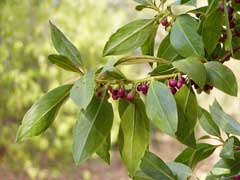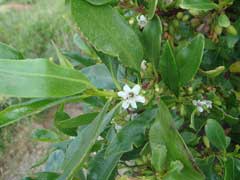 |
|
http://commons.wikimedia.org/wiki/User:Tintazul |
 |
| http://commons.wikimedia.org/wiki/User:Xemenendura |
Translate this page:
Summary
Bloom Color: White. Main Bloom Time: Early spring, Late winter, Mid spring. Form: Rounded.
Physical Characteristics

 Myoporum laetum is an evergreen Shrub growing to 6 m (19ft) by 3 m (9ft) at a medium rate.
Myoporum laetum is an evergreen Shrub growing to 6 m (19ft) by 3 m (9ft) at a medium rate.
See above for USDA hardiness. It is hardy to UK zone 9. It is in leaf all year, in flower from May to June. The species is hermaphrodite (has both male and female organs).
Suitable for: light (sandy), medium (loamy) and heavy (clay) soils, prefers well-drained soil and can grow in nutritionally poor soil. Suitable pH: mildly acid, neutral and basic (mildly alkaline) soils and can grow in saline soils.
It cannot grow in the shade. It prefers dry or moist soil. The plant can tolerate maritime exposure.
UK Hardiness Map
US Hardiness Map
Synonyms
Plant Habitats
Woodland Garden Sunny Edge; South Wall. By. West Wall. By.
Edible Uses
Edible Parts: Fruit
Edible Uses:
Fruit - raw or cooked[153, 177]. The fruit is about 6 - 9mm in diameter[200]. Some caution is advised, see notes above on possible toxicity.
References More on Edible Uses
Medicinal Uses
Plants For A Future can not take any responsibility for any adverse effects from the use of plants. Always seek advice from a professional before using a plant medicinally.
Odontalgic Vulnerary
Odontalgic, vulnerary. The bark is used to treat ulcers[61].
References More on Medicinal Uses
The Bookshop: Edible Plant Books
Our Latest books on Perennial Plants For Food Forests and Permaculture Gardens in paperback or digital formats.

Edible Tropical Plants
Food Forest Plants for Hotter Conditions: 250+ Plants For Tropical Food Forests & Permaculture Gardens.
More

Edible Temperate Plants
Plants for Your Food Forest: 500 Plants for Temperate Food Forests & Permaculture Gardens.
More

More Books
PFAF have eight books available in paperback and digital formats. Browse the shop for more information.
Shop Now
Other Uses
Repellent
Landscape Uses: Border, Espalier, Screen, Standard, Specimen, Woodland garden. A decoction of the leaves is used as an insect repellent[128]. It is effective against mosquitoes[245].
Special Uses
Espalier Scented Plants
References More on Other Uses
Cultivation details
Easily grown in most soils[167] so long as they are well-drained[188]. Succeeds in dry soils[200] and in poor soils[188]. Very resistant to maritime exposure and salt spray[166]. This species is not very hardy in mainland Britain, it succeeds outdoors on the Scilly Isles[1] but usually requires greenhouse protection elsewhere[1]. Plants flower freely in Cornish gardens[1, 59]. Plants do not tolerate temperatures below 0°c[166]. The leaves emit a resinous smell when bruised[245]. The flowers are also fragrant[245]. Special Features: Not North American native, Invasive, Attractive flowers or blooms. Myoporum thrips or naio thrips (Klambothrips myopori) have been documented from California, Hawaii and Tasmania were they are linked to extensive damage of landscape and nursery stock of Myoporum laetum. Many thrips species are pests of commercially important crops. Thrips have caused high levels of mortality in ornamental Myoporum species used for landscaping in residential areas, parks and along road margins. In Hawaii it is attacking the native Myoporum sandwicense, locally known as naio.
References Carbon Farming Information and Carbon Sequestration Information
Temperature Converter
Type a value in the Celsius field to convert the value to Fahrenheit:
Fahrenheit:
The PFAF Bookshop
Plants For A Future have a number of books available in paperback and digital form. Book titles include Edible Plants, Edible Perennials, Edible Trees,Edible Shrubs, Woodland Gardening, and Temperate Food Forest Plants. Our new book is Food Forest Plants For Hotter Conditions (Tropical and Sub-Tropical).
Shop Now
Plant Propagation
Seed - sow spring in a greenhouse. When they are large enough to handle, prick the seedlings out into individual pots and grow them on in the greenhouse for at least their first winter. Plant them out into their permanent positions in late spring or early summer, after the last expected frosts. Consider giving the plants some protection from the cold for their first few winters outdoors. Cuttings of half-ripe wood, 5 - 10cm with a heel, July/August in a frame. Pot up in the autumn. Good percentage[78].
Other Names
If available other names are mentioned here
Native Range
AUSTRALASIA: New Zealand (Chatham Islands Territory, North Island, South Island)
Weed Potential
Right plant wrong place. We are currently updating this section.
Please note that a plant may be invasive in one area but may not in your area so it's worth checking.
Conservation Status
IUCN Red List of Threatened Plants Status :

Growth: S = slow M = medium F = fast. Soil: L = light (sandy) M = medium H = heavy (clay). pH: A = acid N = neutral B = basic (alkaline). Shade: F = full shade S = semi-shade N = no shade. Moisture: D = dry M = Moist We = wet Wa = water.
Now available:
Food Forest Plants for Mediterranean Conditions
350+ Perennial Plants For Mediterranean and Drier Food Forests and Permaculture Gardens.
[Paperback and eBook]
This is the third in Plants For A Future's series of plant guides for food forests tailored to
specific climate zones. Following volumes on temperate and tropical ecosystems, this book focuses
on species suited to Mediterranean conditions—regions with hot, dry summers and cool, wet winters,
often facing the added challenge of climate change.
Read More
Expert comment
Author
G.Forst.
Botanical References
44200
Links / References
For a list of references used on this page please go here
Readers comment